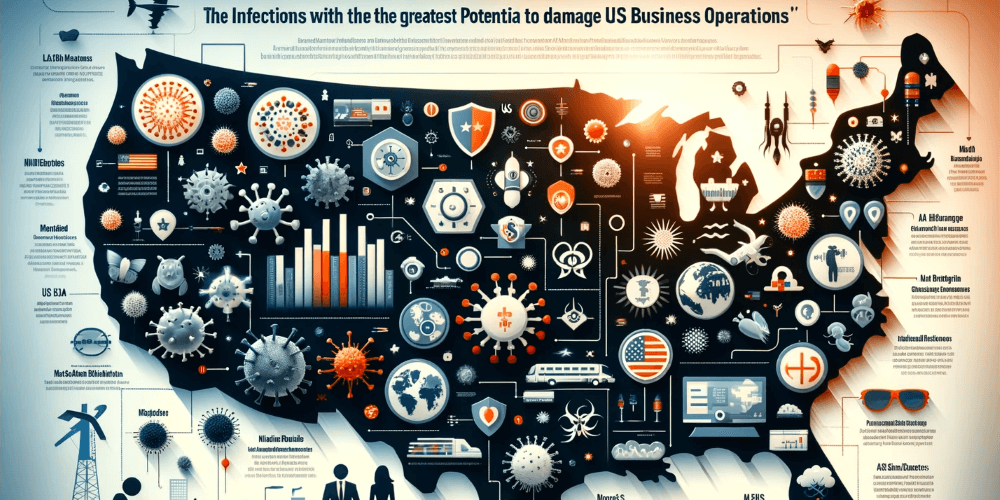Right now, COVID-19 wastewater levels suggest we’re in the midst of the second largest wave of COVID-19 since the pandemic began (behind Omicron). It seems like everyone has a story of being ill themselves with flu, COVID-19, or RSV, or has a story of a loved one who was hospitalized or seriously ill from one of these infections. Workplace absenteeism is elevated from these viruses. HR and CSO leaders can influence behaviors and policies in your organizations to keep more employees respiratory virus free, healthy, and able to work. What steps can you take now to achieve this?

Promoting Effective Personal Hygeine Practices
- Adopt a culture in the organization that encourages effective, common-sense behaviors like handwashing, cough/sneeze etiquette, and use of elbow or fist bumps instead of handshakes for greetings. Handwashing, especially before eating, after using the restroom, or after shaking hands with others has been known for generations to reduce disease transmission, especially for respiratory infections. When high-touch surfaces like countertops and door handles are contacted, hand hygiene is key for employees to reduce respiratory infection (and GI infection) risk. HR leaders can model good cough/sneeze etiquette by using a bent elbow to cover the mouth and nose when coughing or sneezing. Then, it is best to immediately perform hand washing (or antiseptic gel use) afterwards. Similarly, modeling greetings other than handshakes, like elbow bumps, can keep more employees healthy during this rampant respiratory virus season. You can circulate and post this infographic in key areas like breakrooms, restrooms, and meeting rooms to promote these approaches with your employees.
Encouraging Non-Presenteeism
- The culture of respiratory virus prevention should also encourage non-presenteeism. That is the concept that employees should stay out of the office when ill with respiratory symptoms, especially when they have fevers. Leadership needs to model this for employees to make it work, as if the leaders stay out when ill, others are more likely to do so. When employees come to work sick, management should be trained to send them out of the office. Remember, it’s much easier to have one key employee out ill than it is to have 10 out because the first sick employee came to work. Virtual work from home arrangements for potentially contagious employees can make this habit easier to adopt.

Vaccination and Masking Policies
- Masking by employees, although politicized, has strong evidence of its effectiveness as a measure that reduces respiratory infection risk. Places that had high rates of masking, like Taiwan, fared much better during the COVID-19 pandemic than the US did. Encouraging employees who wish to mask in the office to do so can make your workplace safer and lead to fewer people being unable to work because of respiratory illness.
- Updated vaccines are now available for influenza, COVID-19, and RSV. Almost all people over 6 months are eligible for influenza and COVID-19 vaccination, and pregnant women or adults over 60 are eligible for RSV vaccination in the US. All three of these vaccines reduce the chances of dying from their respective infections. HR can establish programs to secure vaccine access in the workplace for COVID-19 and influenza vaccines. Leadership can educate employees about eligibility for the RSV vaccine so they consult their healthcare providers about its risks and benefits. Similarly, HR policies should make it as easy as possible for interested employees to get vaccines (provide childcare and PTO for employees pursuing vaccination). Transportation assistance to vaccine-providing sites should be incorporated, and programs bringing the vaccines to the workplace at a variety of hours can boost vaccine uptake in the workplace. Education campaigns about the impressive benefits conferred by these viral vaccines can have significant influence on employees choices about vaccination.
Enhancing the Workplace Environment and Promoting Safe Travel Practices
- Simple in-office air handling measures, we now know, can help make the workplace safer from viral respiratory infections. These include the use of low cost, portable, in-room filtration units and the deployment of basic ventilation improvements (opening doors, windows when possible)
- When employees must travel or go to crowded meeting spaces for work, CSO’s can have an influence on protective precautions employees can take. Extra measures to reduce viral transmission risk (hand washing, physical distancing to the degree possible, pre-travel vaccination, and masking when on planes, trains, etc, all can reduce risk. Allowing employees to travel by private vehicle lessens the chance they will get sick in transit.
- Smoking increases susceptibility to respiratory infections, and smokers get sicker when they get these viruses. Employers and health insurers with whom they contract can incentivize smokers to quit. Added costs of insuring smokers can be passed on to the smokers, as studies have shown doing so increases quit rates. Fewer smokers on the workforce lessens the organization’s overall susceptibility to these respiratory viruses.
- Use antibiotics only when confidently diagnosed with a bacterial infection by a HCP. Most colds, sinus symptoms, and bronchitis are viral, and antibiotics do not help. Overusing them carries significant short and long-term health risks. These include the onset of a dangerous bowel infection after the antibiotics kill off the normal protective bacteria that live in the bowel. Overuse of these medicines also leads to antibiotic resistance (after even a few doses) that impairs the ability to treat infections in the future.
- If employees contract COVID or influenza, they should immediately contact their healthcare provider to see if they are candidates for treatment for those infections with antivirals. Such treatment can be life-saving for some, and shorten the length of symptoms for most.
The first two winters since the darkest days of the COVID-19 pandemic have been characterized by intense proliferation of other respiratory viruses (influenza and RSV). When added to the productivity losses driven by COVID-19 disease, these viruses put a lot of employees out of work and make their employers less competitive. The measures described above can help reduce absenteeism on your teams, and different combinations of them can be adopted by HR and CSO leaders to fit your organization. Remember, no one measure is perfect at prevention of these infections, so the more measures that are adopted, the fewer cases will arise in your employees, and the more resilient your workforce will be.



